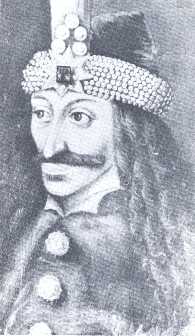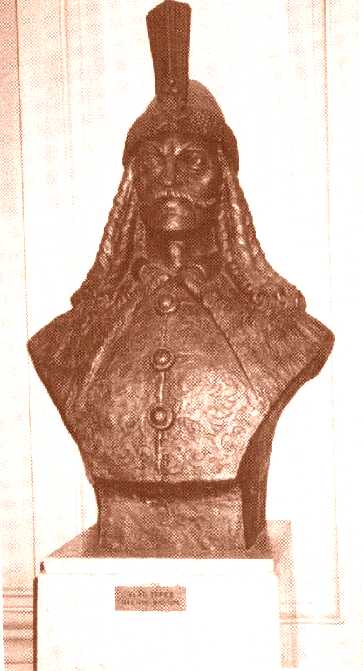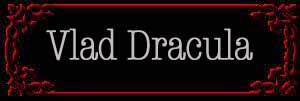|
  Vlad Dracula was a Wallachian prince in the 15th century who became a ruler eventually. He ruled on three separate occasions - briefly in 1448, 1456-1462 and for two months in 1476. Dracula's ancestors stemmed from Wallachia which is the southern-most portion of three Romanian provinces. Vlad was born in Sighisoara, Transylvania. Vlad shared his Christian name with his father. His surname was Dracula while his father's was Dracul. That simple addition of the 'a' indicated that he was the son of Dracul. Dracul and consequently Dracula shared the two meanings of "devil" and "dragon". There is an interchangeability of the words "devil" and "vampire" in many languages may explain the beginning of the connection of the Vlad Dracul with the concept of a vampire. Vlad Dracula was a Wallachian prince in the 15th century who became a ruler eventually. He ruled on three separate occasions - briefly in 1448, 1456-1462 and for two months in 1476. Dracula's ancestors stemmed from Wallachia which is the southern-most portion of three Romanian provinces. Vlad was born in Sighisoara, Transylvania. Vlad shared his Christian name with his father. His surname was Dracula while his father's was Dracul. That simple addition of the 'a' indicated that he was the son of Dracul. Dracul and consequently Dracula shared the two meanings of "devil" and "dragon". There is an interchangeability of the words "devil" and "vampire" in many languages may explain the beginning of the connection of the Vlad Dracul with the concept of a vampire.
His father was a member of the Order Draconis which was established by the Holy Roman Emperor Sigismundthen the king of Hungary. This order was dedicated to the fighting of the Turks (1). Vlad Dracul was imprisoned on a few occasions by the Turks beginning at a very young age. The mental and physical abuse that he endured during these times may help to explain some of his actions and thoughts.
The incidents of Vlad Dracula's father assassination for political reasons, his older brother Mircea being buried alive, other relatives being killed or tortured, his first wife killing herself, subjects conspiring against him and his cousin - a sworn freind, betraying him also may have helped shape Vlad Dracula's mind and personality (2).
His first marriage was unhappy and ended in his wife's suicide. She threw herself out of a tower rather then face enslavement by the approaching Turks. Dracula was quite unfaithful. His second wife was of Hungarian royalty. He was considered a brave warrior. He was also responsible for the erection of five monasteries, despite his atrocities.
Vlad was the historical figure upon whom Bram Stoker partially built his title character in the novel Dracula. Vlad Dracula acquired the nickname Vlad Tepes. Tzepa means "spike" hence the English version of his nickname Vlad the Impaler. He was a master of guerilla warfare. Vlad the Impaler developed all sorts of physical and mental torture. He was often described in contemporary German, Byzantine, Slovanic and Turkish documents and popular horror stories as an awesome, cruel and possibly demented ruler (2).
He indiscriminantly spilled the blood and killed Germans, infidel Turks, Romanians, Hungarians and other Christians (2). Dracul developed a reputation for trickery, cunning, insubordination, brutality, inspiring fright in his own guards, was very suspicious and would trust absolutely no one and was extremely vengeful (2).
Vlad the Impaler is estimated to have killed or ordered the execution of between 40,000 and 100,000 individuals. Vlad had stayed in the safe haven of Sibiu, Transylvania for a while. He enjoyed his time there but just another mark upon his dark personality resulted when he returned after four years with 20,000 Wallachian men and killed, maimed, impaled and tortured some 10,000 of his former fellow citizens and neighbors (2).
 Dracula's favortie method of death was impalement -- hence the nickname Vlad the Impaler. He would ensure that a strong horse was harnessed to each leg of the victim while the stake was gradually introduced in order to not kill the victim instantly (2). He preferred for the stakes to be rounded off so that the gaping wounds that result from a sharp stake would not kill the victim instantly as he enjoyed watching their agonies over a long period of time - either a matter of hours or even a matter of days (2). Dracula's favortie method of death was impalement -- hence the nickname Vlad the Impaler. He would ensure that a strong horse was harnessed to each leg of the victim while the stake was gradually introduced in order to not kill the victim instantly (2). He preferred for the stakes to be rounded off so that the gaping wounds that result from a sharp stake would not kill the victim instantly as he enjoyed watching their agonies over a long period of time - either a matter of hours or even a matter of days (2).
He would have the impaled victims placed in various geometric patterns. Typically they were placed in concentric circles around the city that they were from for all to see. He used high and low speared according to the rank of the individual. He would impale from above with the feet upwards and impale from the bottom with the head upwards or through the heart or navel.
There were instances of nails in peoples heads, maiming of limbs, blinding, strangualtion, burning, the cutting of noses and ears, and of sexual organs in the case of women, scalping and skinnning, exposure to the elements or to the wild animals, and boiling alive (2).
One of Dracula's most publicized events of atrocity was on April 2, 1459. By the end of the day thousands of Saxon burghers were neatly arranged on stakes around the party as they dined. One of his boyars held his nose and Vlad ordered him to be impaled on a stake that was higher than everyone else so he would not be perturbed by the stench (2).
Dracula also decapitated his victims, cut off noses, ears, sexual organs, limbs, hacked them to pieces, burned, boiled, roasted, skinned, nailed and buried them alive (2). He did not personally drink blood but he forced others to participate in cannibalism. He would have the victims run over by a wagon. Some he would have stripped and then skinned alive up to their entrails (2). He would also have some victims heads punctured. Vlad also had victim's breasts pierced or have them pierced from their buttocks until the stake came out of their mouth. He would have women impaled with a red hot poker through the vagina until it emerged from their mouths. He would also pierce a mother's breasts and thrust their babies onto these stakes as well (2).
These are just a few of the ways that Vlad the Impaler devised to torture and kill his victims of choice. His exploits may have been coupled in the European imaginations with those of a legendary vampire (3). The death of Vlad the Impaler has a couple of different stories. We do know that he was decapitated. This is a method by which vampires in a supernatural sense were destroyed (1).
One story is that Dracula was in a battle with the Turks and when he became confident of victory he climbed a hill in the disguise of a Turk to watch the slaughter. One of his followers unable to recognize him attempted to kill him. Dracula fended off five more of his followers before being killed. Another version is that he was assasinated by a force of boyars and personal enemies (2). Either way Vlad the Impaled is remebered today in Romania as a great patriot and a key person in the development of the Romanian nation (4). |
(1) Glut, Donald F., The Dracula Book, The Scarecrow Press, Inc., Metuchen, 1975.
(2) McNally, Raymond T. and Radu Florescu, In Search of Dracula: A True History of Dracula and Vampire Legends, New York Graphic Society, Greenwich, 1972.
(3) Twitchwell, James B., The Living Dead: A Study of the Vampire in Romantic Literature, Duke University Press, Durham, 1981.
(4) Melton, J. Gordon, The Vampire Book: The Encyclopedia of the Undead, Visible Ink Press, Detroit, 1994.
This file created 5/2/00 8:27 AM / IPR held by 'Lacey'. |



 Vlad Dracula was a Wallachian prince in the 15th century who became a ruler eventually. He ruled on three separate occasions - briefly in 1448, 1456-1462 and for two months in 1476. Dracula's ancestors stemmed from Wallachia which is the southern-most portion of three Romanian provinces. Vlad was born in Sighisoara, Transylvania. Vlad shared his Christian name with his father. His surname was Dracula while his father's was Dracul. That simple addition of the 'a' indicated that he was the son of Dracul. Dracul and consequently Dracula shared the two meanings of "devil" and "dragon". There is an interchangeability of the words "devil" and "vampire" in many languages may explain the beginning of the connection of the Vlad Dracul with the concept of a vampire.
Vlad Dracula was a Wallachian prince in the 15th century who became a ruler eventually. He ruled on three separate occasions - briefly in 1448, 1456-1462 and for two months in 1476. Dracula's ancestors stemmed from Wallachia which is the southern-most portion of three Romanian provinces. Vlad was born in Sighisoara, Transylvania. Vlad shared his Christian name with his father. His surname was Dracula while his father's was Dracul. That simple addition of the 'a' indicated that he was the son of Dracul. Dracul and consequently Dracula shared the two meanings of "devil" and "dragon". There is an interchangeability of the words "devil" and "vampire" in many languages may explain the beginning of the connection of the Vlad Dracul with the concept of a vampire. Dracula's favortie method of death was impalement -- hence the nickname Vlad the Impaler. He would ensure that a strong horse was harnessed to each leg of the victim while the stake was gradually introduced in order to not kill the victim instantly (2). He preferred for the stakes to be rounded off so that the gaping wounds that result from a sharp stake would not kill the victim instantly as he enjoyed watching their agonies over a long period of time - either a matter of hours or even a matter of days (2).
Dracula's favortie method of death was impalement -- hence the nickname Vlad the Impaler. He would ensure that a strong horse was harnessed to each leg of the victim while the stake was gradually introduced in order to not kill the victim instantly (2). He preferred for the stakes to be rounded off so that the gaping wounds that result from a sharp stake would not kill the victim instantly as he enjoyed watching their agonies over a long period of time - either a matter of hours or even a matter of days (2).